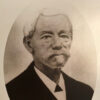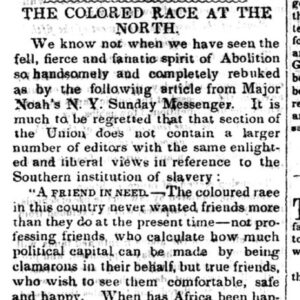calsfoundation@cals.org
Free Blacks
aka: Free Negroes
The terms “Free blacks” or “Free Negroes” refer to people of African descent in the United States who were neither enslaved nor subject to the ownership of another person prior to the Civil War, after which slavery was abolished. Blacks were first documented as coming to Arkansas in the eighteenth century when the French brought slaves with them, and white American settlers in the following decade continued the practice of slavery. Other blacks passed through the region with Native Americans during the period of Indian Removal, both as free blacks and as slaves.
Free blacks seem to have first appeared in Arkansas in 1803, when officials at Arkansas Post recorded 107 slaves and two free blacks in the state. By 1810, there were five free blacks listed as residents in the state of Arkansas. The population of free blacks steadily increased in the United States, at an even rate higher than whites or enslaved blacks, up until 1820, by which time free blacks in the North made up nearly half of the overall free black population. By 1820, there were fifty-nine free blacks in Arkansas, and 608 by 1850. Free blacks could own real estate and personal property, although interracial marriage was outlawed in October 1837. Overall, the free black population continued to grow between 1820 and 1850. Among the men lynched during the antebellum period was a free black man named Bunch who was murdered in Chicot County following an attempt to vote and subsequent altercation.
Freedom was generally achieved by three means: manumission (emancipation from bondage), running away, and self-purchase. Manumission aided in the largest increase of the free black population. Prior to the 1850s, manumission of slaves was possible, but it did not occur frequently. Many of the free blacks in Arkansas were “mulatto,” a term used for people who were descendents of slaves or free blacks and white people. It is quite possible that more mulattos were freed because their owners had some familial or parental relationship to them. Many slaves were also willed their freedom by their owners upon their owners’ deaths.
Many free blacks worked alongside enslaved blacks. In response to poor job conditions, growing numbers began to relocate to urban areas. In the larger, northern cities, an influx of German and Irish immigrants led to competition for jobs and growing hostility toward free blacks. Many were disappointed to find that poor living conditions and racism were as easily found in free states as in southern states.
In Arkansas, a number of free blacks were employed as workers on the steamboats along the Arkansas River; however, few free blacks worked on the river banks due to unfavorable working conditions such as swampy land, mosquitoes, and snakes. One noteworthy community of free blacks arose in Marion County along the White River, led by settlers Peter Caulder and David Hall. There, free blacks numbered approximately 130 and lived with a remarkable degree of freedom for the time.
Of the urban population of free blacks nationally, the majority were women (a 105–92 ratio), and most were light skinned. Historians suggest that this was a reflection of light-skinned blacks’ ability to maneuver more easily in the legal system. In the cities, free blacks often secretly taught urban slaves to read and write, as urban slaves had more mobility and less supervision than slaves on plantations. Urban, city-dwelling free blacks often worked to buy the freedom of family members, many of whom resided in rural Arkansas.
In 1820, there were fewer than 2,000 slaves in Arkansas, but by 1860 there were upwards of 111,000 slaves in the region. The growing free-black population was viewed as a threat to white settlers and slave owners. In response, the Arkansas General Assembly passed a law prohibiting free blacks from entering the state after March 1, 1843; in addition, free blacks were also required to put up a bond to ensure their good behavior. By the 1850s, the free black population had begun to decrease due to the legislation. In 1859, legislation was passed that banned manumission and residence of free blacks in the state; Act 151 threatened any free blacks within the state by year’s end with subjection to one year of slavery in order to pay for their eventual removal. By 1860, the free black population had fallen to 144, with only thirty-five percent residing in the Delta region of the state.
For additional information:
Higgins, Billy D. “The Origins and Fate of the Marion County Free Black Community.” Arkansas Historical Quarterly 54 (Winter 1995): 427–443.
———. A Stranger and a Sojourner: Peter Caulder, Free Black Frontiersman in Antebellum Arkansas. Fayetteville: University of Arkansas, 2004.
Jewett, Clayton E., and John O. Allen. Slavery in the South: A State-by-State History. Westport, CT: Greenwood Publishing Group, 2004.
Milteer, Warren Eugene, Jr. Beyond Slavery’s Shadow: Free People of Color in the South. Chapel Hill: University of North Carolina Press, 2021.
Patterson, Ruth Polk. The Seed of Sally Goodin: A Black Family of Arkansas, 1833–1953. Lexington: University of Kentucky Press, 1985.
Rose, James M., and Alice Eicholz, eds. Black Genesis: A Resource Book for African American Genealogy. 2nd ed. Baltimore: Genealogical Publishing Company, 2003.
Whayne, Jeannie, and Willard B. Gatewood, eds. The Arkansas Delta: Land of Paradox. Fayetteville: University of Arkansas Press, 1993.
Ashlie Perry
Rutgers University
 Louisiana Purchase through Early Statehood, 1803 through 1860
Louisiana Purchase through Early Statehood, 1803 through 1860 Warren, Nathan
Warren, Nathan Free Blacks Article
Free Blacks Article 




Comments
No comments on this entry yet.